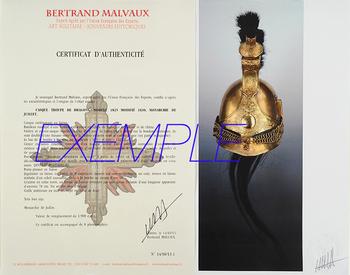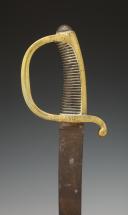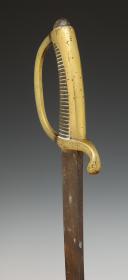
INFANTRY TROOP SABER KNOWN AS "BRIQUET", model An XIII, July Monarchy. 30067
INFANTRY TROOP SABER KNOWN AS A "BRIQUET", model An XIII, July Monarchy. 30067
Single-piece brass hilt with a one-branch guard stamped "PDL" (Property of the State). Handle with 36 twisted wire strands, molded quillon. Slightly curved flat blade, length 59.3 cm.
France.
July Monarchy.
Poor condition, guard in good condition, blade oxidized with dents. Without scabbard.
THE END OF A LEGEND "PDL" STAMP ON NATIONAL GUARD WEAPONS
Extensive research has not allowed me to find any citation that could attest to the reality of this motto "For the right." So, what is it? What is the National Guard? The National Guard was created during the Revolution. It is a militia responsible for maintaining order and the respect for the law in troubled times. It consists of all citizens aged 20 to 60. They are listed and classified for service, either in the reserve guard or active guard. Initially, the National Guards were mostly bourgeois as they were required to equip themselves at their own expense, and to be in the cavalry, one needed to have a horse. This role for the bourgeois was a way to maintain a form of power, to stand out from the rest of the citizen population. The National Guards are distributed throughout all municipalities. They act as the "Police" under the orders of a commander, the mayor, and the prefect. During the Empire, the National Guard sometimes served as a reserve army, mobilized as needed for Napoleon's wars. After the dissolution of the National Guards by Charles X in 1827, it was reestablished by Louis Philippe in 1830. There would be a company in each municipality. Companies of infantry, artillery, cavalry, and firefighters were established. The National Guard was reactivated to quell disturbances and maintain calm throughout France after the July Revolution.
The 1831 'PDL' Weapons Marking
In late 1830, the minister sought to bring order to the National Guards. He aimed to organize the troops and ordered the recovery and inventory of weapons previously distributed during the July Revolution. A document from the Lyon city archives dated August 10, 1830, attests to this.
In January 1831, a ministerial circular decided to mark the weapons that had been distributed by the Ministry of War and thus belonged to the state. These would be stamped with the mark "PDL" denoting "Property of the State," as shown in a document from January 20, 1831, from the prefecture in the Lyon archives.
This mark would be made using a stamp that circulated from village to village in each canton. The stamping would be carried out in the presence of the National Guards gathered in arms by mayors and commanders. The stamp would remain the property of the chief town of the canton, enabling the continuation of these markings in the future. A report would be drawn up, signed by the Mayor, and sent to the prefecture.
It is noted that weapons belonging to the municipalities, purchased at their own expense or by the National Guards, were not subject to this stamping measure.
The armament of the National Guards was quite diverse. They had rifles, sabers, cartridge boxes, and other military-type equipment and uniforms often privately made, somewhat different from standard models. These items were acquired by the National Guards themselves, as well as by the municipalities. Furthermore, there were standard weapons provided to the municipalities as part of the Ministry of War's allocation.
It was only this latter category of equipment belonging to the state that the Ministry sought to mark to establish ownership and prevent the dispersal of weapons. An excerpt of the January 1831 circular reproduces the printed notice accompanying the stamp meant for the municipalities. It details the method to be used for stamping rifles. The same circular also mentions the creation, with the approval of the Minister of the Interior, of an armament manual for the National Guards.
In 1848, following the February Revolution and the establishment of the Second Republic, a decree reactivated the National Guard in March. The front page of the "Courier de la Drome et de l'Ardèche" from October 29, 1848, No. 224, indicates that the same measures as in 1831 (law still in effect) were taken with the inventory of National Guards and their weapons. The 'PDL' marking of state weapons was reaffirmed. Additionally, the transformation to percussion of National Guard weapons by private gunsmiths was prohibited to prevent the proliferation of available calibers.
The 'PLD' Mark
The mark in the wood created by hitting a blackened metal imprint with these three letters 'PDL.' Since long, these have been interpreted as the motto "For The Right," which seems to have no foundation. These documents show that it simply denotes "Property of the State." The rooster situated at the top recalls a national symbol that was emphasized by Louis Philippe upon his rise to power in 1831. This stamp can be found on the stocks of the standard pistols and rifles used in the National Guard, often the 1816 or 1822 troop models and frequently the model 1777 corrected An IX rifles. The Ministry of War supplied the National Guards with weapons of an obsolete system, reserving the more recent 1822 models for the military. Later on, the models 1822 T and Tbis were introduced.
Evolution of the 'PDL' Mark
Furthermore, consulting military archive records uncovered other evolutions in this state identification mark.
Also on White Arms with 'PDL' Mark
Examination of sabers or bayonets sometimes reveals this stamped mention.
http://www.lapistole.com/GDAestampillePDL.pdf
Single-piece brass hilt with a one-branch guard stamped "PDL" (Property of the State). Handle with 36 twisted wire strands, molded quillon. Slightly curved flat blade, length 59.3 cm.
France.
July Monarchy.
Poor condition, guard in good condition, blade oxidized with dents. Without scabbard.
THE END OF A LEGEND "PDL" STAMP ON NATIONAL GUARD WEAPONS
Extensive research has not allowed me to find any citation that could attest to the reality of this motto "For the right." So, what is it? What is the National Guard? The National Guard was created during the Revolution. It is a militia responsible for maintaining order and the respect for the law in troubled times. It consists of all citizens aged 20 to 60. They are listed and classified for service, either in the reserve guard or active guard. Initially, the National Guards were mostly bourgeois as they were required to equip themselves at their own expense, and to be in the cavalry, one needed to have a horse. This role for the bourgeois was a way to maintain a form of power, to stand out from the rest of the citizen population. The National Guards are distributed throughout all municipalities. They act as the "Police" under the orders of a commander, the mayor, and the prefect. During the Empire, the National Guard sometimes served as a reserve army, mobilized as needed for Napoleon's wars. After the dissolution of the National Guards by Charles X in 1827, it was reestablished by Louis Philippe in 1830. There would be a company in each municipality. Companies of infantry, artillery, cavalry, and firefighters were established. The National Guard was reactivated to quell disturbances and maintain calm throughout France after the July Revolution.
The 1831 'PDL' Weapons Marking
In late 1830, the minister sought to bring order to the National Guards. He aimed to organize the troops and ordered the recovery and inventory of weapons previously distributed during the July Revolution. A document from the Lyon city archives dated August 10, 1830, attests to this.
In January 1831, a ministerial circular decided to mark the weapons that had been distributed by the Ministry of War and thus belonged to the state. These would be stamped with the mark "PDL" denoting "Property of the State," as shown in a document from January 20, 1831, from the prefecture in the Lyon archives.
This mark would be made using a stamp that circulated from village to village in each canton. The stamping would be carried out in the presence of the National Guards gathered in arms by mayors and commanders. The stamp would remain the property of the chief town of the canton, enabling the continuation of these markings in the future. A report would be drawn up, signed by the Mayor, and sent to the prefecture.
It is noted that weapons belonging to the municipalities, purchased at their own expense or by the National Guards, were not subject to this stamping measure.
The armament of the National Guards was quite diverse. They had rifles, sabers, cartridge boxes, and other military-type equipment and uniforms often privately made, somewhat different from standard models. These items were acquired by the National Guards themselves, as well as by the municipalities. Furthermore, there were standard weapons provided to the municipalities as part of the Ministry of War's allocation.
It was only this latter category of equipment belonging to the state that the Ministry sought to mark to establish ownership and prevent the dispersal of weapons. An excerpt of the January 1831 circular reproduces the printed notice accompanying the stamp meant for the municipalities. It details the method to be used for stamping rifles. The same circular also mentions the creation, with the approval of the Minister of the Interior, of an armament manual for the National Guards.
In 1848, following the February Revolution and the establishment of the Second Republic, a decree reactivated the National Guard in March. The front page of the "Courier de la Drome et de l'Ardèche" from October 29, 1848, No. 224, indicates that the same measures as in 1831 (law still in effect) were taken with the inventory of National Guards and their weapons. The 'PDL' marking of state weapons was reaffirmed. Additionally, the transformation to percussion of National Guard weapons by private gunsmiths was prohibited to prevent the proliferation of available calibers.
The 'PLD' Mark
The mark in the wood created by hitting a blackened metal imprint with these three letters 'PDL.' Since long, these have been interpreted as the motto "For The Right," which seems to have no foundation. These documents show that it simply denotes "Property of the State." The rooster situated at the top recalls a national symbol that was emphasized by Louis Philippe upon his rise to power in 1831. This stamp can be found on the stocks of the standard pistols and rifles used in the National Guard, often the 1816 or 1822 troop models and frequently the model 1777 corrected An IX rifles. The Ministry of War supplied the National Guards with weapons of an obsolete system, reserving the more recent 1822 models for the military. Later on, the models 1822 T and Tbis were introduced.
Evolution of the 'PDL' Mark
Furthermore, consulting military archive records uncovered other evolutions in this state identification mark.
Also on White Arms with 'PDL' Mark
Examination of sabers or bayonets sometimes reveals this stamped mention.
http://www.lapistole.com/GDAestampillePDL.pdf
Price :
100,00 €
| Destination | Envoi recommandé | Envoi Recommandé + Express |
|---|---|---|
| Shipping France | 20,00 € | 80,00 € |
| Shipping Europe | 33,00 € | 200,00 € |
| Shipping world | 100,00 € | 300,00 € |
Insurance (1%) :
1,00 €
Reference :
30067

Next update Friday, may 2 at 13:30 PM
FOR ALL PURCHASES, PAYMENT IN MULTIPLE CHECKS POSSIBLE
bertrand.malvaux@wanadoo.fr 06 07 75 74 63
An authenticity certificate of the item including the description published on the site, the period, the sale price, accompanied by one or more color photographs is automatically provided for any item priced over 130 euros. Below this price, each certificate is charged 5 euros.
Only items sold by me are subject to an authenticity certificate, I do not provide any expert reports for items sold by third parties (colleagues or collectors).



